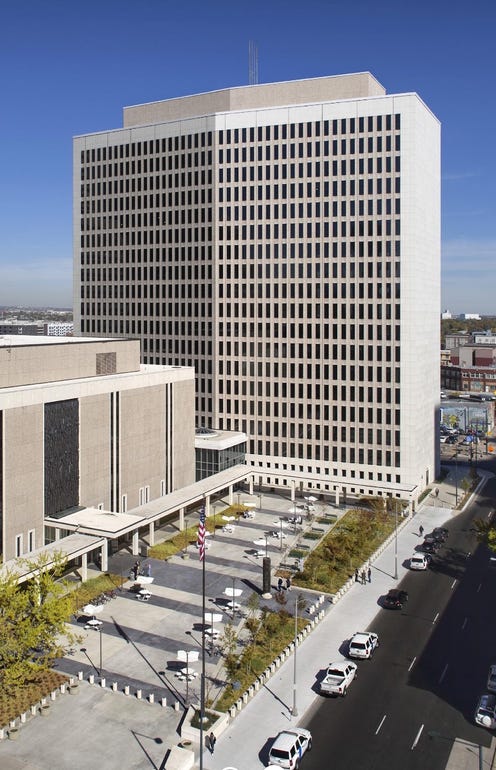The immigration court in downtown Denver isn’t inside the city’s tallest or prettiest building. Across the street from the federal court and a few blocks away from the federal appellate court, it’s not even inside the most distinguished of federal buildings. What it lacks in architectural significance it makes up for in life-changing importance. Three weeks ago, ICE officers began arresting people inside the immigration court moments after immigration judges dismissed the government’s deportation cases. Agents have made similar courthouse arrests in Miami, Seattle, Chicago, and other cities. Targeting people who are appearing for required court dates is likely to discourage other migrants from showing up to court, creating a troubling new front in the Trump administration’s immigration policy.
Judges and advocates have raised concerns about courthouse arrests for years. In several cities and states, ICE is barred by local or state laws from arresting people at or near courthouses. After high-profile ICE arrests at Denver courthouses during Trump’s first term, the Colorado legislature passed a law barring courthouse arrests in 2020. ICE is now taking advantage of a gap in that law. Colorado legislators can enact policies to improve the state’s judicial system, but they are largely powerless to control access to federal courts and federal agencies.
Arresting people at immigration courts might help ICE boost its detention and deportation statistics – at least in the short-run before migrants start changing their behavior to accommodate the agency’s new approach. The administration seems to be hoping that it can use a fast-track deportation option called expedited removal to quickly push people out of the United States. It can’t do that while their legal cases are pending before the immigration courts, so immigration judges, who work for the Justice Department, are doing their part to strip migrants of the process that Congress says they are entitled to.
It’s a dirty tactic that isn’t sure to work. Signed into law by President Clinton in 1996, expedited removal allows front-line immigration officers to detain and remove migrants who arrived in the United States without a visa or who engaged in fraud to get into the country. Historically, the federal government applied expedited removal to people who had arrived within the prior two weeks and only if apprehended within 100 miles of the border. The Trump administration is attempting to extend that period to two years nationwide.
Some of the people arrested at immigration courts in recent weeks likely make poor candidates for expedited removal because Congress created an asylum exception to fast-track deportation. People at risk of persecution can request asylum. Even if an asylum officer working for the Department of Homeland Security concludes someone lacks a credible fear of persecution, the migrant can request review by an immigration judge – bringing the case back to where it began.
Whatever legal pathway follows for individual migrants plucked from the hallways of immigration courts, ICE’s courthouse arrests are likely to create more of the immigration law problems Trump officials complain about. Standing outside the San Antonio immigration court in tears after an immigration judge dismissed the government’s case against his wife only for ICE agents to arrest her, Eduardo Duarte said, ‘No venga nadie. Se los van a llevar a todos.” His advice was clear – show up to immigration court and yours might be the next family lied to and separated. That’s a hard lesson to ignore.
It's too early to know whether the number of migrants who fail to show up for immigration court hearings is going up under Trump. Immigration judges are permitted to issue a removal order against anyone who fails to show up to a hearing at which their attendance was required. In the 2024 fiscal year, immigration judges issued 222,921 in absentia orders of removal, a massive increase from the first Trump administration.
In the meantime, Trump officials are playing with the immigration court system’s legitimacy. By arresting people at courthouses immediately after immigration judges dismiss deportation cases, ICE agents are turning legal proceedings into a weapon. Immigration court cases are necessarily high stress, but they shouldn’t be ambushes.



